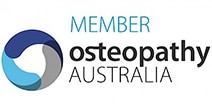FAQs
Osteopathy is a form of manual healthcare that recognises the important link between the structure of the body and the way it functions. They focus on how the skeleton, joints muscle, nerves, circulation, connective tissue and internal organs function as a holistic unit.
No, you can make an appointment directly without a referral. If you have been diagnosed with a chronic medical condition and require complex care you may be eligible for Chronic Disease Management (CDM) assistance. The GP must complete a special referral form (PDF, 201kb) to refer you to an osteopath for treatment.
Bring along any X-rays, scans or test results that you may have.
Yes, you should arrive 5 minutes early for your first appointment as you will need to fill out initial paperwork.
An osteopath will need to record your medical history to assist in discussing treatment options.
Under the law, an osteopath needs to obtain your approval to treat you, so you may be asked to sign an ‘informed consent’ form.
Health fund rebates are unique to each patient. Depending on which health fund you’re with, your level of cover, what you’ve previously claimed and even the time that you’ve spent with your health fund will impact the amount your health fund will cover.
It’s important that you feel comfortable, so wear a comfortable shirt and loose pants or bring a pair of shorts to change into.
Depending on the area of your body requiring treatment, your osteopath may ask you to undress to your underwear. If this is the case you should be offered a gown or covered with a towel.
Yes, you can have someone present throughout your consultation and treatment.
We will ask about your problem and symptoms. This will include your medical history, any medications you are taking or other factors that may not appear to be directly related to your problem.
We will conduct an examination and clinical tests. These include diagnostic, orthopaedic or neurological tests, postural assessments and activities or exercises, which determine how best to manage your condition.
The examination may include passive and active movements. We may lift your arms or legs and you may be asked to bend over or stand in your underwear. Be sure to wear comfortable, flexible and appropriate underwear.
Osteopathy takes a whole of body approach to treatment. We may look at the area that is troubling you as well as other parts of your body. For example if you have a sore knee, your osteopath may also look at your ankle, pelvis and back.
We may also provide education and advice to help you manage your condition between treatments. This may include giving you exercises to do at home or work.
It is important you tell us if your medical condition changes over time. This includes any new injuries or change of medications.
Most osteopathic treatment is manual therapy and should not cause undue discomfort. If your injuries do require hands-on treatment of painful and tender areas, we will aim to make you as comfortable as possible.
There are techniques which may cause some short term discomfort or pain.
You may experience mild soreness for a day or two after treatment, similar to that felt after mild exercise. If this soreness persists or increases significantly, call us to discuss your concerns.
Consultations last for 40 minutes. This includes both initial and follow-up appointments. This time allows us to take a thorough history, examination and treatment unique to your needs.
This depends on your condition. Generally you would expect to see some changes in your symptoms after one or two visits. Long term or chronic conditions may require more treatment.
We will discuss this with you.
Yes. We have a 4-hour cancellation policy. If you fail to notify us of your need to cancel, reschedule or change your appointment time, there is a cancellation fee of $90. This fee is not covered from compensable bodies and must be paid in full by the patient.



